|
|
 |
| SW Aviator Magazine is available in print free at FBOs and aviation-related businesses throughout the Southwest or by subscription. |

|
 |

|
 |
 |
 |
|
The web's most comprehensive database of Southwest area aviation events.
|

|
 |

|
 |
|
Featured Site:
|
|
|
 |
|
A continuosly changing collection of links to our favorite aviation related web sites.
|

|
 |

|
 |
 |
|
|
Through the Looking Glass
|
|
G.A. Pilot to Jet Jockey
|
|
|
I was a pilot looking for a way to celebrate. After years of purposeful training I had achieved my goal of becoming a flight instructor, and was in a position to spend some money on a less practical aviation experience. So after a longtime fascination with vintage military aircraft, I resolved to find my way into an exotic cockpit or two.
Researching the options, I found that instruction in a Stearman or T-6 isn’t terribly difficult to come by. For a bit more of an investment one can take the controls of a P-51 Mustang, which was the front runner in my mind for a while. Another well known company brokers flights in modern Russian fighters, and even trips to the International Space Station. The catch is that you have to travel to Moscow (or earth orbit) to do it. That sounded great, but the price tag was way out of my budget – particularly the latter option at around $20 million, which I suspect doesn’t include tax and tips.
Then I found the Jetwarbird Training Center in Santa Fe, New Mexico. Their website revealed a specialization in aerobatic and jet training with a stable of six aircraft: T-34, L-29, L-39, Fouga Magister, MiG-15, and T-33.
Hmmm . . . MiG-15, eh? That certainly fit the bill for my CFI celebration! So the day after Christmas 2003, I headed for New Mexico to get a whiff of Jet-A.
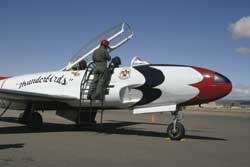 I arrived at the Santa Fe Municipal Airport on a windy, bitterly cold Saturday morning. On the ramp I saw the usual assortment of light aircraft and business jets, with a few jet trainers and fighters mixed in. They were wearing desert camouflage livery, and I grinned with the knowledge that they would be my rides for the next few days. I arrived at the Santa Fe Municipal Airport on a windy, bitterly cold Saturday morning. On the ramp I saw the usual assortment of light aircraft and business jets, with a few jet trainers and fighters mixed in. They were wearing desert camouflage livery, and I grinned with the knowledge that they would be my rides for the next few days.
At a small office painted in the same camouflage as the planes, I was greeted by instructors Larry Salganek and Dale “Duke” Faust. Recently retired after a 22-year military career, Duke had been an Air Force instructor pilot in T-33’s and F-15’s, while Larry came to Warbirds as a civilian instructor and airshow performer. Their focus is on training, and I had asked for an introduction to aerobatics during my flights, having previously been through only aileron rolls and spins.
Today Duke and I would fly the L-39 Albatross, and he began a very thorough pre-flight briefing using a computer presentation and oversized cockpit photograph. The L-39 was built in the 1970’s, and is a simple aircraft by jet standards. Duke talked about the aircraft systems, engine start, taxi technique, aerobatic maneuvers, and emergency procedures. He concluded the briefing by assuring me I would have a big smile etched on my face after the flight that would take hours to go away.
The experience didn’t seem real to me until I was strapped securely in the front cockpit and began the engine start procedure. First I pressed the turbine button and held it for about fifteen seconds. This produced a whine as the Auxiliary Power Unit (APU) began spooling up. When the turbo indicator illuminated on the panel I pressed the button to light the engine, which made a *whump* sound. The smell of Jet-A wafted into the cockpit, which started me on the smile Duke had predicted.
After supervising the engine start, Duke hopped into the rear cockpit and began talking me through the taxi and brake check. There is a hand lever on top of the control stick that looks like a bicycle brake. To stop straight ahead you center the rudder pedals and squeeze the handle. To turn, you push a pedal all the way to the stop before squeezing the lever. The degree of turn depends not on rudder position, but on the amount of pressure with which you pull the lever. Although I had done it once before in a friend’s Yak-52, this type of braking is completely contrary to what I’m used to in most general aviation airplanes. Like many novices to the L-39, my tendency was to try to steer with the rudder pedals rather than using modulated amounts of brake pressure from the lever.
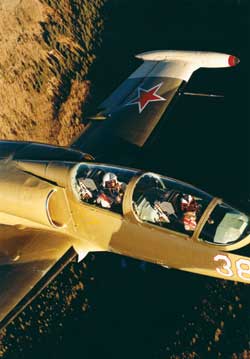 Lined up on runway 20, Duke had me spool up the engine to check the gauges and brakes. Everything looked good and the brakes were released. The takeoff roll in the L-39 is initially slow, but then builds up in speed rapidly. It flew itself off the runway, I retracted the gear and flaps, and we began a climbing right turn toward the practice area. The plane is very pitch sensitive, and it can be difficult to notice a shallow climb or descent because you sit so far in front of the wing. A slight bump that might result in a gain of 50 feet in a prop trainer resulted in a gain of 500-1000 feet in the L-39. Lined up on runway 20, Duke had me spool up the engine to check the gauges and brakes. Everything looked good and the brakes were released. The takeoff roll in the L-39 is initially slow, but then builds up in speed rapidly. It flew itself off the runway, I retracted the gear and flaps, and we began a climbing right turn toward the practice area. The plane is very pitch sensitive, and it can be difficult to notice a shallow climb or descent because you sit so far in front of the wing. A slight bump that might result in a gain of 50 feet in a prop trainer resulted in a gain of 500-1000 feet in the L-39.
After giving me a few minutes to feel out the plane, Duke called for a climb. As I teach my students, I gently raised the nose and began to smoothly feed in power. But this is a jet, not a Piper Warrior. “Here, let me help you with that,” Duke said, hauling back sharply on the stick. A couple of g’s and PRESTO! There we were at 14,500’ with both of us laughing.
The L-39 handles beautifully through slow flight and stalls, although it takes about 12 seconds for the engine to spool up to full thrust from idle. This makes stall recoveries interesting if one is hasty in raising the nose.
Unfortunately, clouds had begun to close in and we only had time for a few aileron rolls before heading back to the airport for pattern work. The tower cleared us in for a touch and go, which I flew with Duke’s coaching. The plane was not difficult to land, although I again found it difficult to determine the pitch attitude. I was surprised to see the nose drop a considerable distance to the ground after the mains touched down.
After one more landing we taxied back, and Duke remarked that my first jet flight did indeed result in a big smile on my face!
The next day Larry and I flew the strange looking Fouga Magister. A French trainer, the airplane sits very low to the ground and sports a butterfly tail. It looks like a cross between a go-cart and a Beech Bonanza. I resisted the urge to compare it with other examples of questionable French engineering (remember “Le Car”?), and after climbing into the front cockpit I found it much tighter than the L-39. This is the type of plane that you wear rather than sit in. After getting settled in the parachute and seat straps I reached for the hand crank to adjust the rudder pedals, only to discover they were already set as far forward as they would go. I’m not a big guy, and I wondered how taller pilots fit in the airplane.
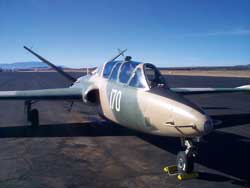 The Fouga is a twin-engine turbojet, and the startup procedure was not automated as in the L-39. The noisiest of all their airplanes, it made a cacophonous racket. After issuing our takeoff clearance the tower controller added, “And we thought it was going to be a quiet afternoon.” The Fouga is a twin-engine turbojet, and the startup procedure was not automated as in the L-39. The noisiest of all their airplanes, it made a cacophonous racket. After issuing our takeoff clearance the tower controller added, “And we thought it was going to be a quiet afternoon.”
Today we would be focusing more on aerobatics, and the briefing included a method of straining the body against g-forces. Shortly after reaching altitude and doing some turns, Larry called for a loop. I’ll bet not many people get to do their first loop in a jet trainer, and it was with some trepidation that I followed Larry on the controls as he demonstrated. “OK, tighten up. And . . . pull.” Four-g’s began pressing me into the seat, and we headed upstairs in a hurry.
Then something amazing happened: I went from a state of anxiety to one of euphoria in less than a second. Before reaching the top of the loop I realized I absolutely loved it. I performed the next two with Larry’s coaching, and marveled at the desert floor rotating around the canopy as if in an IMAX film. Cuban-8’s and an Immelman followed, and what seemed like only moments later it was time to head back to the airport. I must have been having fun or something.
The Fouga handled delightfully in the pattern, and Larry claimed not to have touched the controls during my two touch-and-go’s and one full stop. After shutting down and popping the canopies I thanked him for the single most enjoyable hour I had ever spent in an airplane.
Duke had remarked that, in addition to the flying experience, I was also getting a unique history lesson through their airplanes. And the MiG-15 was the historical highlight. Although usually out-flown by American pilots in F-86 Sabres during the Korean War, the MiG was a tough customer, capable of much mayhem when flown by an aggressive pilot. The U.S. once paid a North Korean defector $100,000 for his MiG-15. Just over fifty years later I would fly one on my vacation in New Mexico.
I quickly received the impression that the MiG was a very serious airplane, and not to be trifled with. Its swept-back wings are great for going fast, but a disadvantage in slow flight. They put out a lot of drag at high angles of attack, which can make for disastrous takeoffs and landings if the airplane is mishandled. Spins and even straight ahead stalls were to be avoided.
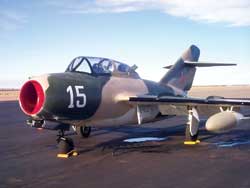 The two-seat MiG-15UTI that we would be flying was built in 1953. In reading the manual the night before I was slightly unnerved to find the words “first generation ejection seat.” Further reading about spinal injuries and the need to manually separate oneself from the seat was unsettling. However, Larry assured me that an ejection would be necessary only in the event of a major failure of the controls or airframe, or fire. He felt these scenarios were almost out of the question, as he had never heard of a MiG coming apart in flight. The two-seat MiG-15UTI that we would be flying was built in 1953. In reading the manual the night before I was slightly unnerved to find the words “first generation ejection seat.” Further reading about spinal injuries and the need to manually separate oneself from the seat was unsettling. However, Larry assured me that an ejection would be necessary only in the event of a major failure of the controls or airframe, or fire. He felt these scenarios were almost out of the question, as he had never heard of a MiG coming apart in flight.
I recalled Larry’s words after squeezing myself into the tiny rear cockpit to find I could just barely crunch up my body into the required position for ejection. The seat is deep in the MiG’s fuselage, with the canopy rails at shoulder level and the ejection seat handle on the lower right. A utilitarian black, the cockpit struck me as almost menacing.
Larry narrated what he was doing so I could follow along on the checklist as the MiG started up with a rumble. On the runway we throttled the engine to 9000 rpm with the brakes holding us in place. With all the gauges in the green Larry called back, “We’re out of here, buddy!” Brakes were released and we began the takeoff roll, the MiG accelerating faster than the other jets. The nose came up, we held attitude for a moment, and began climbing out.
Larry gave me control just after liftoff and I executed a climbing turn to 12,500’. After leveling off we let the plane accelerate, and it seemed to come alive as we went through 300 knots.
A 400-knot loop in a MiG-15 is something everyone should experience once, and I plan to do it again. However, a demonstration of slow flight really showed the effect of the swept wings. At 140 knots the stick could be fully deflected to either side with hardly any effect. Turning at that speed would be a delicate exercise, and inadvisable at low altitude. The MiG didn’t seem to care for doing anything under 250 knots.
Back at the airport we did one touch-and-go and a full stop. Having glanced warily at the ejection seat handle a few times, I felt as if I had just taken a tiger for a walk on a leash. Fortunately, it hadn’t been inclined to bite.
My final flight at the Jetwarbird Training Center was to be in the Lockheed T-33, sometimes called the “Piper Cub of jets.” Their specimen has a stunning Thunderbirds paint scheme, and most museum examples don’t look as good. This airplane managed to be a fashion plate while still working for a living.
As usual we discussed the aircraft’s systems and emergency procedures. The jet pipe temperature had to be watched carefully, and throttle movements had to be slow. Although their T-Bird didn’t have a hot ejection seat, the canopy could be jettisoned if necessary. Today’s aerobatics would include barrel rolls and a split-S.
I walked with Larry on the pre-flight, pulling out warning banners and checking fuel caps. After climbing the ladder I found the T-Bird’s cockpit to be snug, but much more inviting than the MiG’s. You sit more on top of it, rather than down low in the fuselage like the MiG, and the seat can be raised. The improved view made the T-33 seem more inviting than its Russian stable mate.
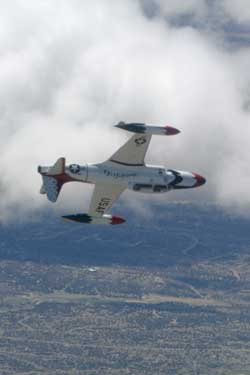 A quick taxi to the active runway (the Santa Fe controllers are good about getting these gas guzzlers out quickly) and soon we were rolling for takeoff. Larry gave me control after the gear came up and I soon found the T-Bird was quite sensitive in roll. Very easy to induce an oscillation, and this called for small finger pressures on the stick. A quick taxi to the active runway (the Santa Fe controllers are good about getting these gas guzzlers out quickly) and soon we were rolling for takeoff. Larry gave me control after the gear came up and I soon found the T-Bird was quite sensitive in roll. Very easy to induce an oscillation, and this called for small finger pressures on the stick.
At altitude I found the view to be the best from any of their planes, and it was beautiful to see the desert and mountains slide through my sight lines. We proceeded with aileron rolls, barrel rolls, loops, and a split-S. Having become a “g-junky” almost overnight, I relished the sensations of throwing the airplane around the sky. “Not having any fun, are you?” Larry asked.
I flew the plane back into the pattern and Larry took it on final. One tidy landing and short taxi later and my jet fighter adventure had ended.
Upon reflection of the experience I was struck by how Duke and Larry’s matter-of-fact demeanor at times masked the unique nature of their operation. I sometimes felt I was at just another flight school. The office has the usual photos, shelf of manuals and videos, and dog-eared copies of the FAR’s. However, this flight school just happens to use MiG’s and L-39’s instead of Cherokees and Skyhawks. Their emphasis on training and safety were always at the fore. We made a detailed plan for each flight, I was carefully prepared, and my logbook credited.
As a primary instructor, it was good for me to once again feel intimidated by an airplane, and anxious about new maneuvers. Larry and Duke have that great asset to instructors called “calm.” They were able to give clear instructions while upside down and pulling g’s, despite the fact that I was often so far behind the airplane that I would have needed to board a commercial flight to catch up. That’s a trait I hope to cultivate in myself as I continue instructing in the more sedate confines of a Piper Warrior.
The only down side of the experience is that rather than scratching my itch for military jets and aerobatics once and for all, I’ve opened the door to a new obsession. I’m already planning another trip to Santa Fe for their formal course in aerobatics.
Note to self: start saving pennies.
Jason Catanzariti is an elementary Physical Education teacher in Monticello, NY. Prior to becoming a teacher Jason made his living as an entertainer, doing a juggling and unicycle act. Jason says he always wanted to learn to fly, and that his background in juggling gave him a love of novel and challenging skills. Jason holds a commercial and instrument rating, and earned his flight instructor’s license in July 2003. |
| The material in this publication is for advisory information only and should not be relied upon for navigation, maintenance or flight techniques. SW Regional Publications and the staff neither assume any responsibility for the accuracy of this publication's content nor any liability arising fom it |
|
|